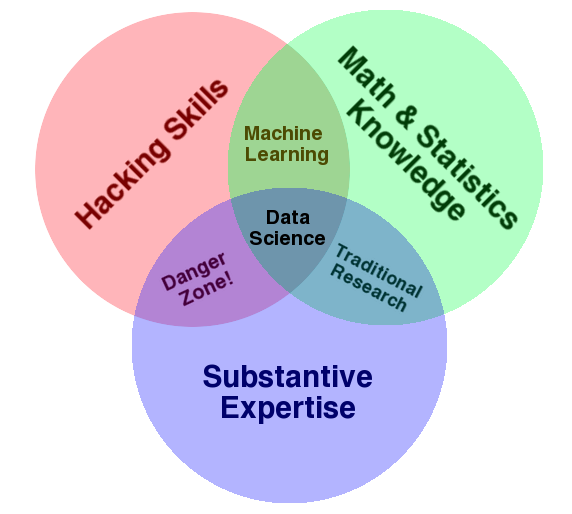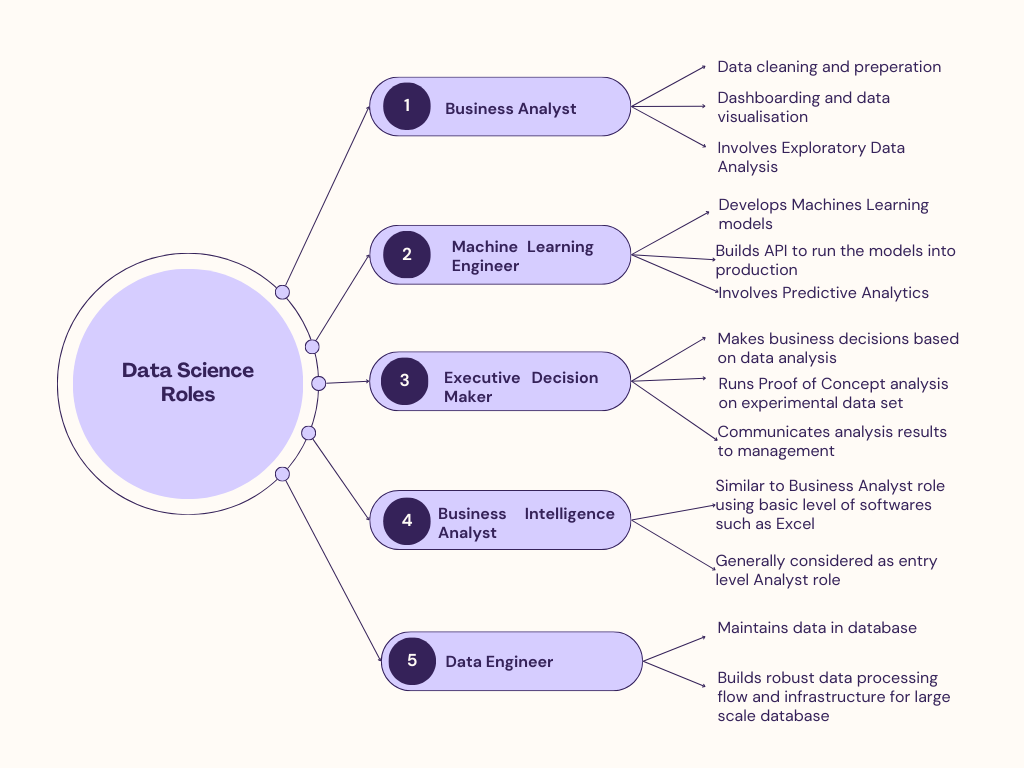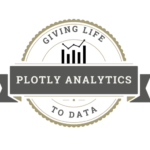
Data science is the practice of using data to try to understand and solve real-world problems. If you’ve looked into the different areas of data science, you may be familiar with Drew Conway’s popular data science Venn diagram.
In Conway’s opinion (at the time of the diagram’s creation), data science fell into the intersection of math and statistical knowledge, expertise in a domain, and hacking skills (that is, coding). You can mix and match these three core skills of data science into several roles.

Each of these roles serve different purpose for the organisation and delivers different results. From Data Science perspective, there are three core roles that one can find in the industry: –
– Business Analyst
– Machine learning Engineer
– Executive decision maker
Business Analyst
The job of an analyst is to take data from within the company, format and arrange it effectively, and deliver that data to others.
For e.g. after company sets its yearly targets, Business Analyst will put those goals on dashboard so that management can track progress every week/month. The dash-boarding work involves lot of data cleaning and preparation but generally less work to interpret the data. Business Analyst will be more concerned on data quality and reliability issues, because the dashboard KPI shall be referred by the company management to make business decisions.
Thus, much of the work carried by Business Analyst involves devising meaningful data visualizations. This work also entails using data transformation, data cleaning and creating compelling dashboards that update automatically each day without errors.
Machine Learning
A machine learning engineer develops machine learning models and puts them into production, where they run continuously.
A machine learning engineer spends less time on things like creating dashboards and more time doing the programming work of data science. The programming work involves building predictive models for specific business problems such as reducing customer churn, designing recommender systems and monitoring a model in production, making sure its performance hasn’t degraded since its deployment.
Machine learning engineer’s primary role is to create machine learning models that get deployed into production or turn into Application Programming Interface (API) for other machines.
Thus, Machine learning engineer follows best software engineering practices to produce robust, tested and memory efficient code so that other people will be able to work with it. For this reason, many machine learning engineers
come from computer science background.
Executive Decision Maker
This role involves making business decisions based on analysis carried out on raw data.
This position leans more towards business strategy than data analysis. However, it is expected the executive decision
maker understands basic statistical methods and have baseline familiarity with predictive modeling techniques. Executive decision maker uses insights generated by dashboards or machine learning systems for business decision
making.
Executive decision makers occasionally dive into coding as well, either to run a machine learning model on an experimental data set before fully completed production level code is created or to conduct a exploratory data analysis on a particular topic. Coding is more frequently used to test proofs of concept than to create fully functional applications. Hence decision makers can get away with having code that’s inefficient or difficult to maintain.
Furthermore, Executive decision makers have to be able to make compelling presentations using lots of graphs, charts and tables so that the nontechnical people they talk to will understand their analysis
Related Jobs
While the three categories covered in the previous sections represent the majority of data science job types, there are a few unique opportunities that may be seen that do not fit into those categories.
Business Intelligence Analyst (BIA)
Job function of Business Intelligence Analyst (BIA) is similar to that of an Data analyst, however BIA create less-sophisticated output because of the limitations of their tools and techniques. BI analyst will use Excel to create Dashboard, while Business Analyst will use more advanced tools such as Power BI or Tableau to create the dashboards. Business Intelligence Role is generally considered as stepping stone to more elaborate Data Science role, especially if you haven’t work with data with business setting before.
Data Engineer
A data engineer focuses on keeping data maintained in databases and ensuring that people can get the data they need. They don’t run reports, make analyses, or develop models; instead, they keep the data neatly stored and formatted in well-structured databases so that other people can do those things. Data Engineer is responsible for building robust
data processing flow and supporting infrastructure for large scale databases, so that data quality is maintained and data can be used in right format for analysis.

Where do you stand?
At this point, it’s good to start reflecting on the area of data science you want to specialize in. Where do you already have experience? Which background do you have? Data science is relatively new field, thus many data scientist are former engineers, social workers, business managers and statistic students. It is helpful to reflect now on which part of Data Science roles you are in.
Are you happy with it?

Your point of view caught my eye and was very interesting. Thanks. I have a question for you.
Hello,
Sure! Please let me know how I can help you to address your query.